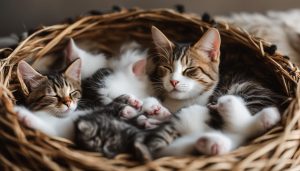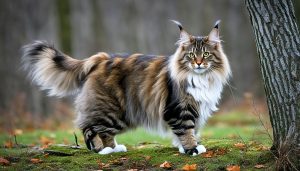Cats are fascinating creatures with a language all their own. While they might not use words like humans do, they communicate through their body language, including their tail movements. Decoding a cat’s tail behavior is crucial for understanding their mood, intentions, and overall well-being.
Interpreting cat tail movements can provide valuable insights into a cat’s emotional state and help pet owners strengthen their bond with their feline companions. By understanding the nuances of cat tail language, we can better respond to their needs and ensure their happiness.
So, let’s dive into the world of cat tail behavior and explore the various messages our furry friends convey through their tails.
Key Takeaways:
- Cats use their tail movements, along with other body language cues, to communicate.
- Decoding a cat’s tail behavior is essential for understanding their mood and intentions.
- Understanding cat tail language can help identify signs of illness or pain.
- Cat tail movements provide insights into emotions such as fear, confidence, and excitement.
- Observing a cat’s entire body language is crucial for accurate interpretation.
Why It’s Important To Decode a Cat Tail’s Meaning
Understanding a cat’s body language, including their tail movements, is crucial for interpreting their communication signals. By decoding cat tail behavior, pet owners can gain valuable insights into their feline companion’s emotions and intentions. This understanding allows for a deeper connection and more effective interactions with our furry friends.
Reading Cat Tail Language
Cats have a unique way of using their tails to convey a range of emotions and messages. Just like humans use facial expressions and body postures, cats utilize their tails as a form of nonverbal communication. It is essential to pay close attention to the various tail movements and positions to accurately understand a cat’s state of mind.
Deciphering cat tail behavior involves recognizing the specific signals and their corresponding meanings:
- An upright tail indicates a confident and sociable cat.
- A lowered, tucked tail suggests fear, anxiety, or submission.
- A curled question mark-shaped tail is a friendly invitation for interaction.
- A fluffed-up tail indicates startlement or fright.
- A wrapped tail around the body typically signifies fear, defensiveness, pain, or illness.
By understanding these cat tail signals, pet owners can better gauge their cat’s emotional state and respond accordingly, providing comfort or creating a more positive environment.
The Key to Recognizing Negative Emotions and Health Issues
Decoding a cat’s tail behavior is especially important when it comes to identifying signs of distress, fear, or potential health issues. Cats may express their discomfort through specific tail movements, offering valuable clues for early detection and intervention.
Some indications of negative emotions or health problems include:
- Rapid twitching or thrashing of the tail may signal irritation or anger.
- Slow swishing from side to side could indicate intense focus or readiness to pounce.
- Quivering tail, in some cases, can serve as a sign of excitement or urine marking.
By staying attuned to these cat tail signals, pet owners can promptly address any underlying issues and ensure their cat’s well-being.
Quotes:
“Decoding a cat’s tail behavior is like understanding a secret language they speak. It helps us connect with our feline friends on a deeper level and provide the care and attention they need.” – Dr. Emily Anderson, Feline Behavior Specialist
Understanding Cat Tail Language
Cat tail language is a crucial form of communication that every cat owner should understand. Just like how humans use facial expressions and body language to convey their emotions, cats use their tails to express their feelings and intentions. By paying attention to their tail movements, you can gain valuable insights into their emotional state.
Here are some common cat tail expressions and their meanings:
- Upright Tail: An upright tail indicates a social and confident cat. When a cat holds its tail up high, it often signals their approachability and openness for social interaction.
- Lowered Tail: On the other hand, a lowered tail suggests fear or anxiety. When a cat holds its tail low to the ground or tucked between its legs, it typically means they are feeling threatened or insecure.
- Curled Question Mark-shaped Tail: A cat with a curled question mark-shaped tail is extending a friendly invitation to interact. This tail position is often seen during playtime or when a cat is happy and content.
- Fluffed-up Tail: A fluffed-up tail indicates startlement or fright. When a cat feels threatened or scared, they may puff up their tail to appear larger and more intimidating.
- Tail Wrapped Around Body: When a cat wraps its tail tightly around its body, it typically signals fear, defensiveness, pain, or illness. It’s a protective gesture aimed at shielding vulnerable body parts.
Understanding these cat tail wagging meanings can help you better interpret your cat’s emotions and respond accordingly. By recognizing the subtle nuances of their tail language, you can strengthen your bond with your feline companion and ensure their well-being.
Deciphering the Tail Language
“Cat tail language serves as a window into a cat’s emotional world. A simple tail movement can reveal their state of mind and help you create a harmonious environment for your feline friend.”– Dr. Emily Johnson, Feline Behavior Specialist
Decoding cat tail behavior may sometimes be challenging, as tail movements alone do not provide the complete picture. It’s essential to consider other elements of a cat’s body language, such as their ear position, eye contact, and overall posture. These combined signals offer a more comprehensive understanding of your cat’s emotional state and intentions.
Next, we’ll delve deeper into why cats wag their tails and how to interpret their specific tail movements.
Why Do Cats Wag Their Tails?
Cats use their tails as a crucial communication tool, expressing various emotions through different tail movements. Each tail wagging behavior carries a distinct meaning, allowing us to better understand our feline companions.
Thumping Tail: A thrashing or thumping tail indicates irritation or anger. It’s a clear sign that your cat is displeased or feeling threatened, and it’s best to give them some space.
Twitching Tail: When the end of the tail twitches, it can signify a few different emotions. It may indicate hunting instincts kicking in, especially when your cat is focused on something specific. It can also be a mild sign of irritation or frustration.
Swishing Tail: Slowly swishing the tail from side to side usually indicates intense focus or readiness to pounce. This behavior is often observed when a cat is concentrating on prey or anticipating playtime.
Quivering Tail: A quivering tail typically signals excitement or arousal. However, in some cases, it can also indicate urine marking. If you notice your cat quivering their tail while going to the litter box, it may be a sign of marking behavior.
Cat Tail Wagging Behaviors
| Tail Movement | Meaning |
|---|---|
| Thumping or Thrashing | Signifies irritation or anger |
| Twitching | May indicate hunting, mild irritation, or frustration |
| Swishing | Indicates intense focus or readiness to pounce |
| Quivering | Typically denotes excitement, but can also indicate urine marking |
Understanding these tail movements is essential for decoding your cat’s emotions and ensuring their well-being. By paying attention to their tail behavior, you can respond appropriately and provide a harmonious environment for your furry friend.
Why Do Cats Wrap Their Tails Around You?
Just as humans use handshakes or hugs to greet one another, cats may greet by wrapping their tails around people or interweaving their tails with other cats. This behavior signifies a willingness to interact and is considered affiliative. While tail movements provide valuable insights into a cat’s emotional state, it’s essential to consider their overall body language for a complete understanding.
Deciphering Feline Affection
Cats are known for their independent nature, but their tail behavior can reveal their affectionate side. When a cat wraps its tail around you, it’s a way of expressing trust and forming a bond. It’s their way of saying, “I feel comfortable and safe around you.”
While some cats may only wrap their tails gently, others may entwine them tightly or flick them lightly against your leg. Each cat is unique in how they display their affection, so it’s essential to pay attention to their individual tail behavior.
Signs of Trust and Comfort
The act of wrapping their tails around you shows that cats feel secure in your presence. It’s a gesture of trust and indicates that they view you as part of their social group. This behavior is often seen between closely bonded cats and is a way for them to reinforce their social connections.
When a cat wraps its tail around you, it’s an invitation to interact and engage with them. They may rub their body against your legs and purr, further indicating their contentment and desire for your attention. Responding positively to this behavior can help strengthen your bond with your feline companion.
Interpreting with Context
While tail wrapping is generally an indication of positive feelings, it’s essential to consider the context and other body language cues. By observing the cat’s overall behavior, you can gain a deeper understanding of their intentions and emotional state.
For example, if a cat wraps their tail around you tightly while their ears are flattened and their body is tense, it could indicate fear or anxiety. Conversely, if their ears are relaxed, their body is loose, and they purr while their tail is wrapped around you, it likely indicates contentment and trust.
Remember that each cat is an individual, and tail behavior can vary. It’s crucial to familiarize yourself with your cat’s specific tail language to interpret their actions accurately.
Understanding cat body language, including tail behavior, is essential for building a strong bond with your feline companion. By paying attention to their tail movements and considering their overall body language, you can communicate effectively and provide the care and attention they need and deserve.
The Importance of Taking the Whole Body into Account
When it comes to understanding cat behavior, decoding their tail signals is just one piece of the puzzle. To gain a comprehensive understanding of a cat’s emotions and intentions, it’s crucial to take their entire body into account. Paying attention to other physical cues, such as posture, eye contact, and ear position, can provide valuable context and deeper insights into their behavior.
For example, if a cat’s tail is raised high while their body is stiff and their ears are pinned back, it could indicate aggression or fear. On the other hand, if the tail is held low with a relaxed body and ears facing forward, it may suggest a content and relaxed cat.
By observing the cat’s body as a whole, you can better interpret the meaning behind their tail movements. It’s important to remember that tail signals are not standalone indicators but are influenced by the cat’s overall body language. Taking a holistic approach allows you to read cat tail signals more accurately and understand their behavior on a deeper level.
Here’s a visual guide to help you interpret different cat tail signals:
| Tail Position | Meaning |
|---|---|
| Upright tail | A sign of confidence and a friendly cat |
| Curled tail | An invitation for interaction and playfulness |
| Lowered tail | Indicates fear or anxiety |
| Fluffed-up tail | A sign of startlement or fright |
| Tail wrapped around body | Typically signals fear, defensiveness, pain, or illness |
Remember, interpreting a cat’s behavior is a nuanced process, and tail signals should be considered alongside other body language cues. Taking the whole body into account ensures a more accurate understanding of your feline companion’s emotions and needs.
Cats’ Burst of Energy and Zoomies
Cats are known for their adorable and sometimes unpredictable behavior. One common occurrence that many cat owners are familiar with is when their feline companion suddenly bursts with energy, a phenomenon often referred to as “the zoomies.”
These episodes involve sudden bursts of speed as cats race around the house, jump on furniture, and engage in playful antics. These energetic outbursts can sometimes catch owners off guard, but they are a natural behavior for cats.
The zoomies serve as outlets for a variety of emotions that can accumulate in cats, such as arousal, frustration, fear, or pent-up energy. These bursts of energy are believed to be remnants of their wild ancestors’ hunting instincts. In the wild, cats would have had to expend energy quickly to capture prey or escape from predators.
During a zoomie session, a cat may exhibit various behaviors, including:
- Sudden bursts of speed
- Darting from one room to another
- Running in circles
- Jumping on and off furniture
- Engaging in acrobatic maneuvers
What Causes Cat Zoomies?
There are several factors that can trigger a cat’s zoomies:
- Stimulation: Cats may become overstimulated by new toys, scents, sounds, or the presence of other animals.
- Release of energy: Cats that spend a significant amount of time indoors may accumulate energy that needs to be released.
- Boredom: Lack of mental and physical stimulation can lead to restlessness and the need for playful activity.
- Mood elevation: Cats may experience moments of heightened mood or happiness, leading to bursts of energy.
Just like humans need exercise and play to stay healthy, cats also require outlets for their energy and natural instincts. The zoomies are a way for cats to release built-up energy and engage in natural behaviors.
It’s important to note that while the zoomies are generally harmless, owners should ensure that their cats have a safe environment to prevent accidents or damage to household items. Providing interactive toys, regular playtime, and opportunities for exploration can help channel their energy in a positive way.
Understanding and appreciating a cat’s burst of energy and zoomies can strengthen the bond between owners and their feline companions. These playful moments are a reminder of their natural instincts and the joy they bring to our lives.
Cats’ Fascination with Stealing
Some cats exhibit fascinating behavior that can be reminiscent of a hunter’s instincts: stealing. These sneaky felines have a penchant for carrying and hiding various objects, such as socks or jewelry, within their territory. This intriguing behavior may stem from their innate need to hunt and pounce on prey, even in a domesticated setting. Alternatively, it could be a result of a lack of stimulating hunting opportunities in their environment.
Understanding a cat’s stealing behavior is crucial for providing them with appropriate outlets to express their natural instincts. By offering interactive toys, play sessions, and puzzle feeders, pet owners can encourage their furry friends to engage in hunting-like activities that satisfy their primal desires.
“Cats approach the world as an ecosystem of interactive prey, and their stealing behavior is an expression of their primal instincts.” – Dr. Samantha Collins, Animal Behaviorist
Additionally, cat owners can create dedicated hunting zones within their homes, equipped with hiding spots, scratching posts, and interactive toys. These spaces provide an environment where cats can engage in hunting-like behaviors and satiate their desire for exploration and agility.
The Benefits of Addressing Stealing Behavior:
- Physical and Mental Stimulation: Providing cats with appropriate outlets for hunting can enhance their overall physical fitness and mental well-being.
- Preventing Boredom and Destructive Behavior: Engaging cats in hunting activities can prevent them from becoming bored and resorting to destructive behaviors, such as scratching furniture or excessive meowing.
- Bonding and Enrichment: Creating interactive play sessions not only strengthens the bond between cats and their owners but also provides enriching experiences that fulfill their natural instincts.
To better understand why cats exhibit stealing behavior, it’s important to delve deeper into their hunting instincts and provide suitable outlets for their innate predatory tendencies. By nurturing their primal needs, cat owners can cultivate a harmonious and stimulating environment for their furry companions.
| Benefits of Addressing Stealing Behavior |
|---|
| Physical and Mental Stimulation |
| Preventing Boredom and Destructive Behavior |
| Bonding and Enrichment |
The Unique Behaviors of Different Cat Breeds
Different cat breeds exhibit their own distinct behaviors, including variations in tail movements and tendencies to swipe objects. Understanding these breed-specific behaviors can provide valuable insights into a cat’s tail behavior and overall communication style.
One example of a cat breed known for its unique behaviors is the Munchkin. Munchkins are characterized by their short legs, which give them a distinctive appearance. This breed is known to have an energetic and playful nature, often engaging in zoomies, where they race around the house with bursts of energy.
Another breed worth mentioning is the Siamese cat. Siamese cats are known for their vocal nature and their ability to communicate through a wide range of vocalizations. They often use their tails as an extension of their communication, displaying specific movements and positions to convey their mood and intentions.
On the other hand, Maine Coon cats, known for their large size and tufted ears, tend to have a more laid-back and gentle demeanor. They often exhibit graceful tail movements, swishing their tails in a relaxed manner to express contentment or curiosity.
In contrast, the Bengal cat, a breed known for its wild appearance, may have more active and vigorous tail movements. Bengals are highly energetic and enjoy active play sessions. Their tail movements can reflect their level of excitement and engagement.
There are many more cat breeds, each with their own unique set of behaviors and tail movements. Understanding these breed-specific behaviors can help cat owners build stronger connections with their feline companions and provide tailored care based on their individual needs and preferences.
Conclusion
Decoding a cat’s tail behavior is an essential aspect of understanding their mood, intentions, and overall well-being. By observing and interpreting their tail movements, pet owners can strengthen their bond with their feline companions and provide them with the necessary care and enrichment they need.
Cats communicate through a variety of body language cues, and the tail plays a crucial role in conveying their emotions. Whether it’s a raised tail indicating confidence and sociability, a lowered tail signaling fear or anxiety, or a question mark-shaped tail inviting interaction, each movement carries meaning.
Understanding cat tail language not only allows us to better interpret their feelings but also helps us identify signs of illness or pain. For example, a wrapped tail around the body often signifies fear, defensiveness, or discomfort. By being attentive to their tail behaviors, we can offer our cats the support and care they require.
By applying this knowledge, pet owners can create a harmonious and enriched environment for their feline friends. Providing appropriate outlets for their energy and natural instincts, such as playtime and interactive toys, helps prevent behavioral problems and promotes their overall well-being. Decoding a cat’s tail behavior is a gateway to building a stronger connection with our beloved companions and ensuring their happiness and contentment.










